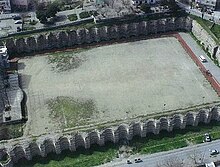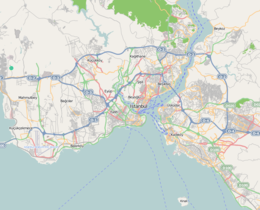Cistern of the Hebdomon
Fildamı Sarnıcı | |
 | |
| Location | Bakırköy, Istanbul, Turkey |
|---|---|
| Region | Marmara Region |
| Coordinates | 40°59′35″N 28°53′10″E / 40.99306°N 28.88611°E |
| Type | Cistern |
| History | |
| Periods | Byzantine Empire |
The Cistern of the Hebdomon (Greek: κινστέρνη τοῦ Ἕβδομου), known in Turkish as Fildamı Sarnıcı ("Cistern of the elephant's stable"),[1] is a Byzantine open sky water reservoir built in the quarter of the Hebdomon (today's Bakırköy), an outskirt of Constantinople.[2]
Location
The cistern is located in
History
The date of construction of this cistern, which lay in the outskirts of the Hebdomon (
After the
Description
The cistern has a rectangular plan with sides 127 metres (417 ft) long and 76 metres (249 ft) wide, and covers an area of about 9,600 square metres (103,000 sq ft).
In the same small valley where the cistern lies, and to its west, there are three smaller elliptic open cisterns, aligned from north to south.[9] The central one is destroyed, while the other two, still extant, are named Domuzdamı ("house of the pigs"), since they were used as stables for animals.[9]
See also
References
- ^ a b c d e f g h i j Mamboury (1953), p. 326
- ^ a b c d e Janin (1964), p. 205
- ^ Janin (1964), p. 446
- ^ a b c d e f g h Goncal, Serhat (2009). "Fildami Cistern, its role in Constantinople and its historical background through history". Retrieved 6 September 2014.
- ^ a b Janin (1964), p. 447
- ^ Janin (1964), p. 448
- ^ a b c d Altun (2009), p. 142.
- ^ a b c Bambaşka Bakırköy Gazetesi (in Turkish) (10): 14. March 2009.
{{cite journal}}: Missing or empty|title=(help) - ^ a b Janin (1964), p. 206
Sources
- Mamboury, Ernest (1953). The Tourists' Istanbul. Istanbul: Çituri Biraderler Basımevi.
- Janin, Raymond (1964). Constantinople Byzantine (in French). Paris: Institut Français d'Etudes Byzantines.
- Altun, Feride Imrana (2009). Istanbul'un 100 Roma, Bizans Eseri (in Turkish). Istanbul: Istanbul Buyukșehir Belediyesi Kültür A.Ş. Yayınları. ISBN 978-9944-370-76-9.

